RECOIL OFFGRID Preparation Emergency Communications: Baofeng and Beyond
In This Article
In an emergency, communications can be a matter of life and death. It’s the third leg of the tactical triad: shoot, move, communicate. It’s also a crucial part of many non-combat emergency preparedness frameworks. Every aircraft pilot is reminded of three top priorities during training — aviate (keep flying the aircraft), navigate (be sure you’re traveling in a safe direction), and communicate (stay in touch with air traffic control).
Regardless of the emergency situation you find yourself in, the importance of comms cannot be overlooked.
In emergency and preparedness circles, the merits of various radio equipment and modes of communication are hotly debated. Even within the handheld radio sub-category, there are thousands of models to choose from. However, when it comes to communications, one thing sets it apart from all other gear debates: it takes two to communicate.
If you have no one to talk to, or the person on the other end can’t receive your call, it doesn’t matter how great your gear is. Every emergency communications plan must take this interoperability factor into consideration.
So, we’ve established that you need several handheld radios to help your family and friends stay in touch during emergencies, and you need each handheld radio to be able to communicate with the broadest number of people possible. The ubiquitous Baofeng UV-5R (or its sibling, the F8HP) seems to be the standard choice for a cheap and versatile radio — it’s not a bad option for beginners, but it’s far from the best choice.
If you’ve never bought a handheld radio, or you already own a few and have decided it’s time to upgrade, you should consider your options carefully. In this article, I’ll present some of my favorite radios at different price points for those who are looking for something more sophisticated and powerful than the old UV-5R.
My selection criteria for these recommendations are the following:
At the low-end, I’m starting with a Baofeng UV-9R Plus. Yes, I know, it’s odd for me to be suggesting a Baofeng to replace another Baofeng (UV-5R/FH8P), but based on my criteria, I think this is either a good first radio, or one you should strongly consider as a replacement for your old UV-5R.

Above: The Baofeng UV-9R Plus is a cost-effective alternative to radios such as the UV-5R, giving the user the same capabilities but in a rugged package more suitable to hard use in a disaster or civil defense scenario.
Availability
The UV-9R Plus can be had for only $30 – depending on color – as of the time of this writing and can be obtained from retailers such as Amazon. For about $50, you can get a package with two batteries, programming cable, shoulder-mounted speaker mic, earpiece, charger, etc.
Interoperability
The UV-9R is an analog VHF/UHF, FM ham radio that is software unlockable to get out of the 2m and 70cm ham bands. As such, you’re able to talk with anyone else using analog FM on or around the 2m and 70cm bands, from other Baofeng users to those running high-end rigs.
Adoption
From a user perspective, the UV-9R is just another Baofeng, so anyone with experience using a Baofeng will be able to pick it up and go. The menu interface is the same as a UV5R, and it works with the popular Chirp programming software as well.
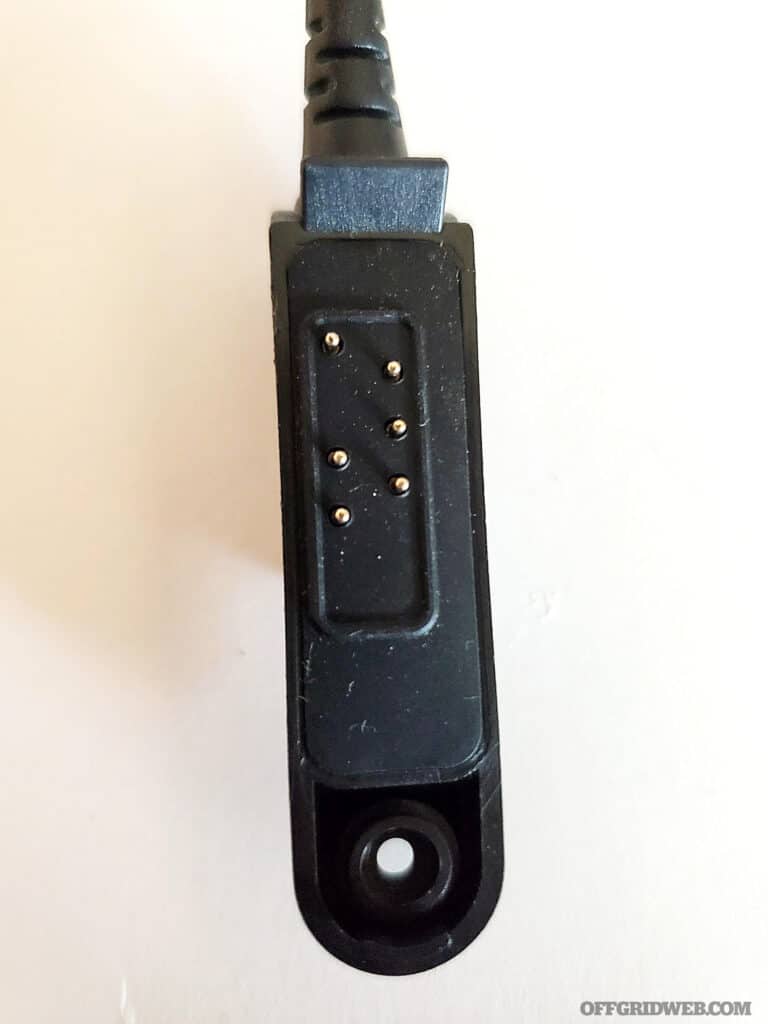
Above: Disco32 and Armorwerx both make PTTs for the water-tight Baofeng multi-pin connection. The radio also ships with an Abree shoulder mic.
Resilience
The UV9R Plus is IP67 rated for dust and water resistance. This means the radio is completely protected from dust and can survive immersion in 1m of water for a short period of time. Dropping this radio in a puddle or using it in a rain or dust storm is no problem.
The radio also claims to be drop-proof. Possibly related to this — and definitely an improvement over a UV-5R — is an extended collar protecting the volume/power knob, helping reduce the likelihood that it gets accidentally turned at a tactically inopportune time. The collar may also protect it from breakage to a degree.
Where this radio shines, even in comparison to the next one that I’ll be discussing, is the screw-down, three-point connector for shoulder mics and push-to-talk (PTT) add-ons. This radio enables you to use tactical accessories without compromising the waterproofing.
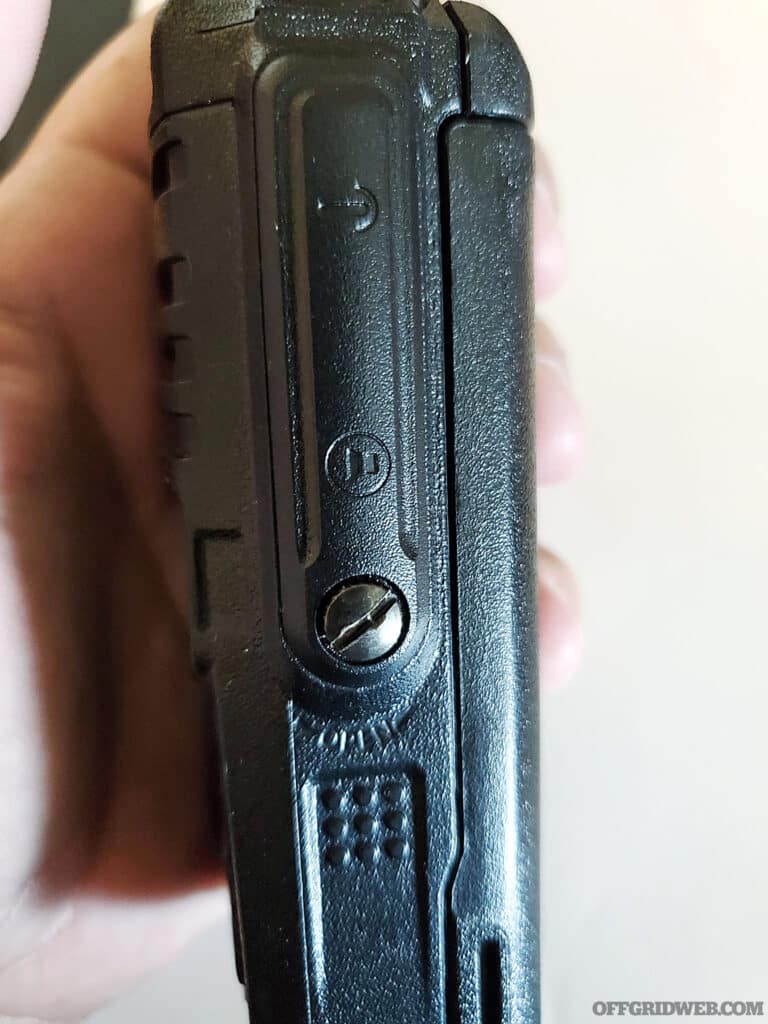
Above: The major difference between the UV-9R and the UV-5R is the screw-down, multi-pin connector.
Ecosystem
The greatest drawback to the UV-9R Plus is that this transceiver is essentially the “end of the line” in terms of where you can go from here. This is a result of the proprietary nature of its pinout connection. While the body is similar in form to, say, a Motorola or Hytera connector, the pinout isn’t compatible. This is a notable difference from the UV-5R, which uses a non-proprietary Kenwood two-pin connector.
However, that doesn’t mean you can’t accessorize or run the radio with high-end accessories. This is because multiple vendors, such as Disco32 and Armorwerx provide NATO-spec U94 PTTs with Baofeng Multipin downleads. They can be had in amplified or non-amplified version, depending on whether you’re using a military-grade, low-impedance headset (such as Peltor Comtacs) or using a more budget-friendly, high-impedance rig (such as Howard Leights with a multi-mount microphone). But before you spend hundreds of dollars on adapters and specialized accessories for your Baofeng, consider if that money would be better spent on a more capable radio.
Overall Impression
I give the Baofeng UV9R Plus a rating of 7 out of 10. For the price, you really can’t beat it. It makes a much better first option than a Baofeng UV-5R. Even in the most inexpensive package, it comes with a lot of supporting equipment out of the box that even lower-end Yaesu radios (which come in at a slightly higher price point) don’t have.
The only downside really is the proprietary connector, which may make some people think twice, at least if they wanted to work this into a tactical kit.
The Radioddity GS5B may seem like a strange choice for a recommendation at a mid-level price point. Its $109 MSRP puts it in the range where you might want to consider a Yaesu FT-65 or maybe even a Yaesu FT-60. However, for many people, such as those for whom preparedness is about things such as natural disasters or public safety, the GS5B really shines. In fact, my personal radio for my search and rescue kit is a GS5B.
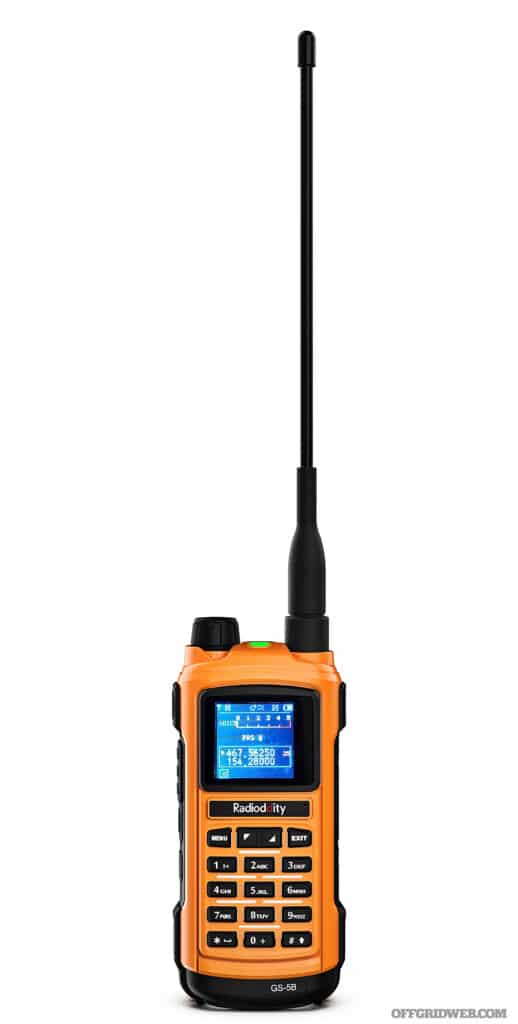
Above: The GS-5B, in addition to being more rugged than a UV-5R, has a SWR meter on the display and can simultaneously monitor and receive A and B channels.
Availability
The GS5B is almost always available from retailers such as Amazon and is often on sale for about $85 with Prime shipping.
Interoperability
The GS5B is a dual-band, VHF/UHF radio that’s software unlockable and functions in the MURS and FRS/GMRS bands as well.
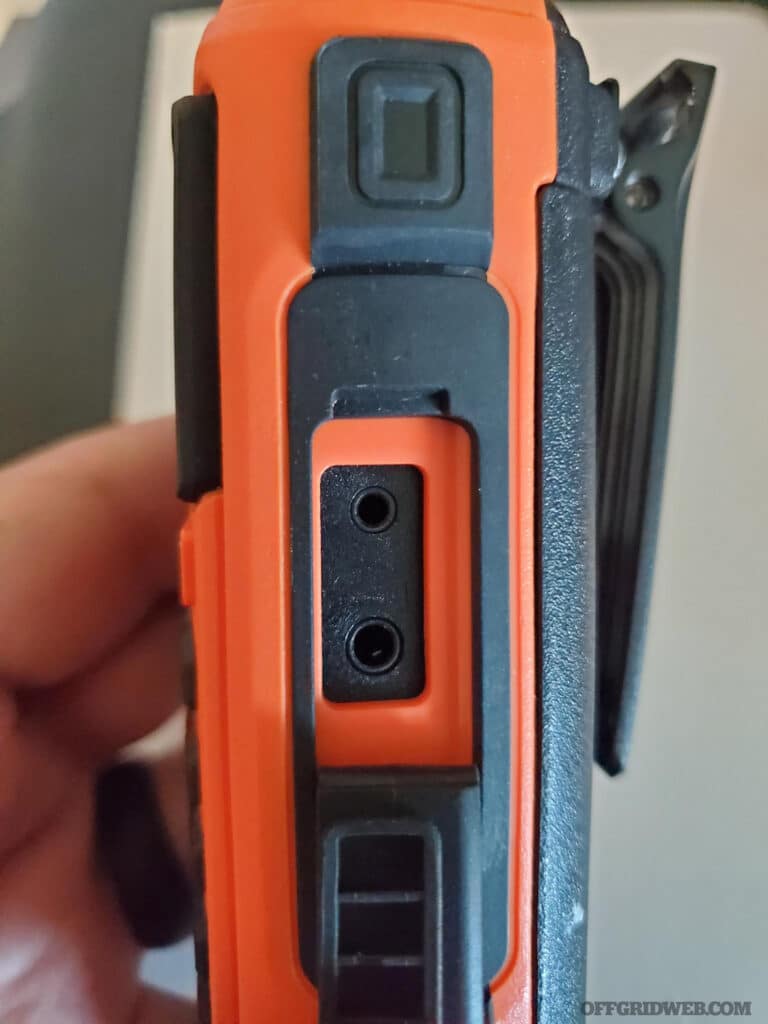
Above: Disco32 (pictured) and Armorwerx both make NATO-spec PTTs for the water-tight, Yaesu screw-down connector, making this a prime choice for an analog radio to be integrated into your plate carrier, chest rig, or other civil defense gear.
Adoption
The GS5B has its own proprietary programming software, and to be honest, it isn’t the best. However, this is mitigated by the fact that the radio can also be programmed via Bluetooth with a phone app while on the go. Both of these options have some learning curve associated with them, and this may be the weakest point of the radio for many people.
Resilience
The GS5B is IP56 rated, meaning it’s not entirely dust or water-tight, but is definitely rain-proof and should be good to go for dust in most areas of operation. I’ve personally used this radio for over a year, both as a SAR volunteer and personally. I keep it in my car in Texas heat, take it with me on family trips from the East Coast to the Grand Canyon, and use it during search and rescue operations. I’ve never had an issue with this radio at all.
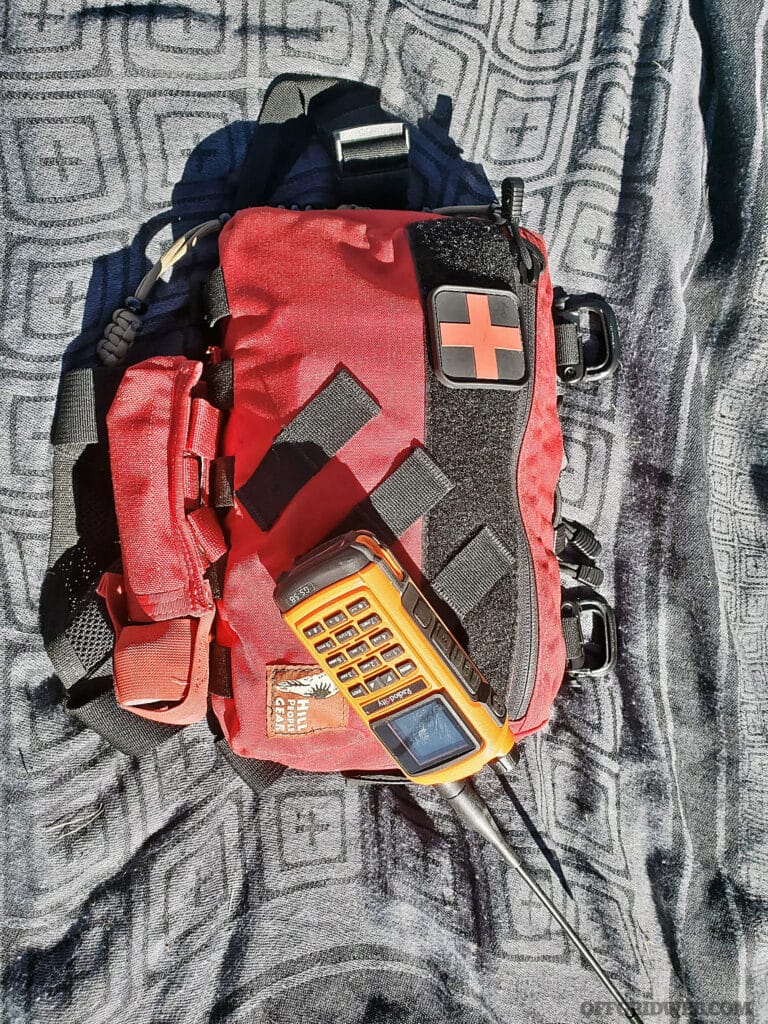
Above: The features and construction of the GS5B make it an excellent choice for use in a public safety role. Mine is a key part of my Search and Rescue kit, living on my Hill People Gear SARv2 chest rig.
Ecosystem
The GS5B uses a two-pin Kenwood connector just like your old UV-5R does. All your UV-5R accessories should still work with it — all of mine do. If this radio is just a step up from a Baofeng for you while you consider moving on to a higher-end radio, you could buy all the high-end accessories such as PTTs you want right now and leverage any other radio using the Kenwood connector in the future.
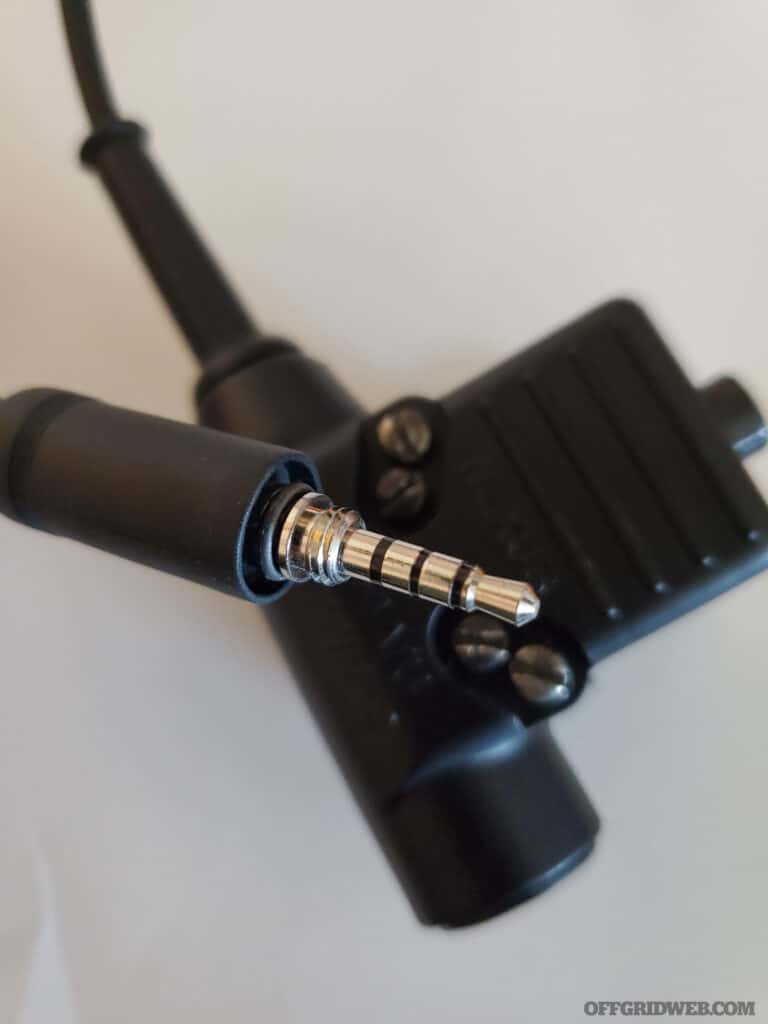
Above: UV-5R users should recognize the two-pin Kenwood connector on the side of the GS5B. It makes this radio compatible with existing UV-5R radio accessories, such as PTTs and shoulder mics.
Overall Impression
The Radioddity GS5B does fairly well in all the evaluation criteria, with adoption perhaps being the lowest score because of lack of Chirp software support. However, it has specific features which make it attractive over other radios in a similar price point, depending on personal use case.
The first is dual monitor combined with dual PTT. This radio can simultaneously receive both the A and B channels you have configured, even if they are in different bands. The dual PTT allows you to talk on either, without having to switch between your A and B channel first (as you’d need to on most other handheld radios). This can also be used to monitor a broadcast channel for news and a group or family communications channel.
The high-visibility color and integrated flashlight make this an excellent choice for use in public safety situations such as search and rescue, hurricane or earthquake preparedness, etc. These features do, however, detract from the value of this radio in a civil defense/minuteman type of use case where concealment may be a necessity.
The Yaesu VX-6R is my personal favorite handheld radio, and the one analog ham radio that I’d really trust my life to. That’s a tall claim, but this is one that has never let me down over many years of frequent use.

Above: Yaesu’s VX-6R is an outstanding, dependable choice in the premium handheld radio category. Unless your needs are more specialized or you’re switching to digital, it might be the last handheld you need to buy.
Availability
All major ham radio stores carry the VX-6R. Unlike its Chinese compatriots, it may not always be readily available on Amazon, though certain accessories may be had from there. Expect to spend approximately $250 on one of these radios.
Interoperability
The VX-6R does a lot out of the box, and far surpasses the other radios that I’ve discussed in terms of information gathering. Its wide-band receiver capabilities enable it to listen in on HF and shortwave transmissions, AM airband traffic, and broadcast radio. However, since it is an FCC-compliant ham radio, it does come locked to the 2m/1.5m/70cm VHF and UHF ham bands.
Unlike the Chinese radios, which often play fast and loose with FCC rules, the VX-6R does require a hardware MARS (Military Auxiliary Radio System) modification to open it up for use on FRS/GMRS and MURS frequencies. This can be purchased as a $35 add-on service from distributors such as Ham Radio Outlet and Gigaparts, or it can be done yourself, if you’re so inclined. (See sidebar for details.)
Adoption
Recently, support for the VX-6R has reached Chirp, so it’s no longer necessary to purchase a third party programmer such the one from RT-Systems, though their programming cable is quite good. The radio doesn’t come with a programming cable.
The requirement of a hardware MARS/CAP mod is probably the biggest hurdle to adoptability of this radio for non-HAM purposes. One must either be comfortable with working on electronics or willing to spend a little extra to purchase the radio from a source that can do the modification on your behalf.
Unlocking Your VX-6R with the MARS Mod
Unlocking the VX-6R is straightforward but does require some basic electronics skills and tools. You will need a soldering iron and soldering wick to perform the operation.
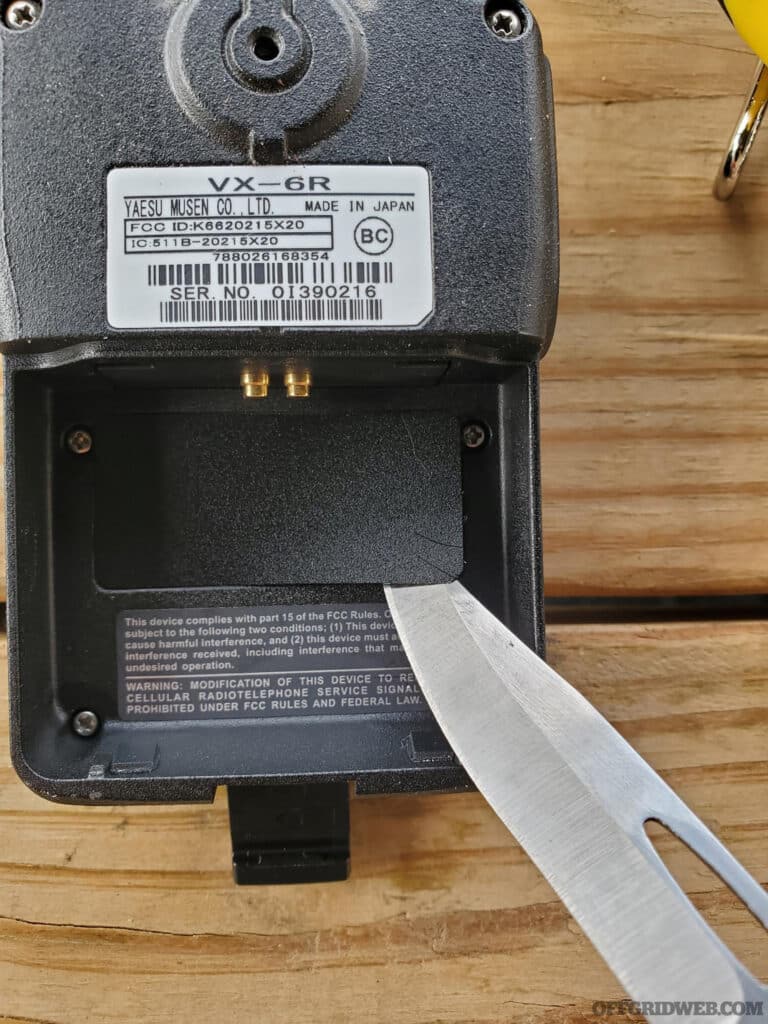
Step 1. Remove the battery and peel back the protective film in the battery compartment to expose the circuit board.
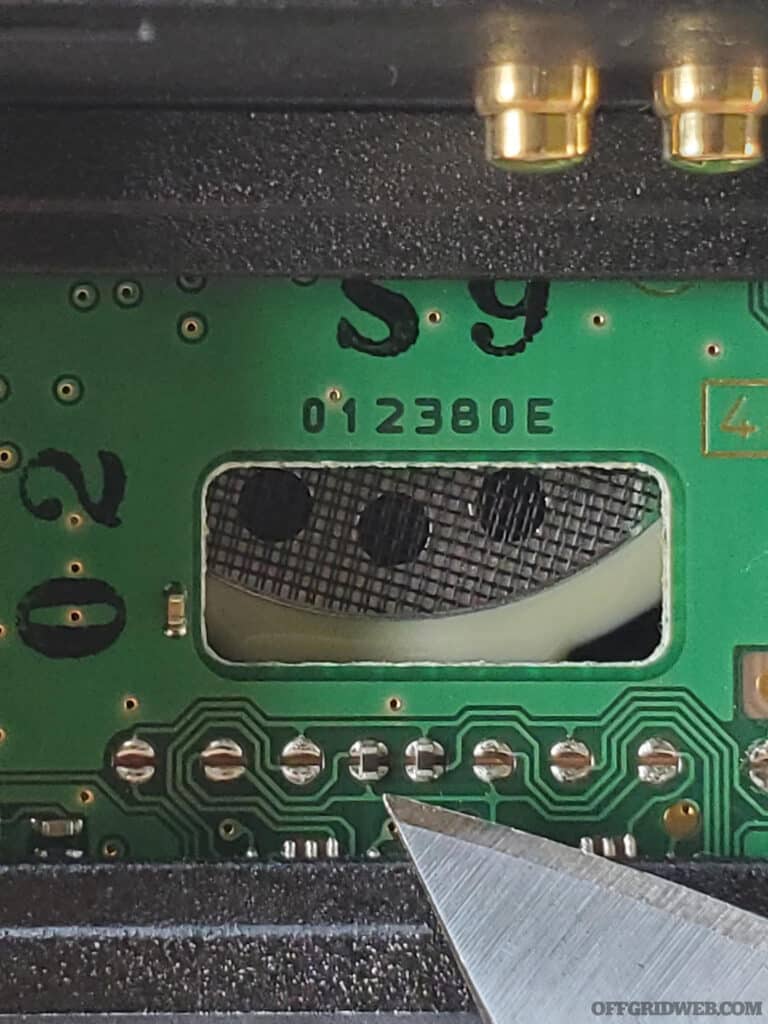
Step 2. Identify the soldered jumpers (4th and 5th from the left) underneath the cutout on the PCB.
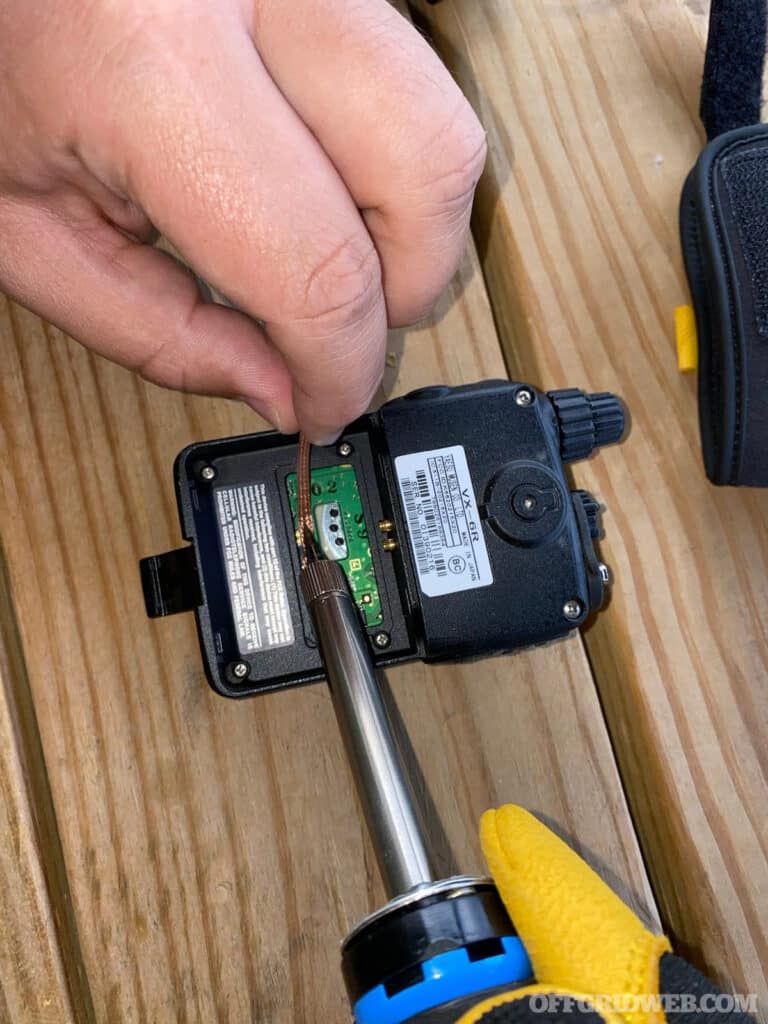
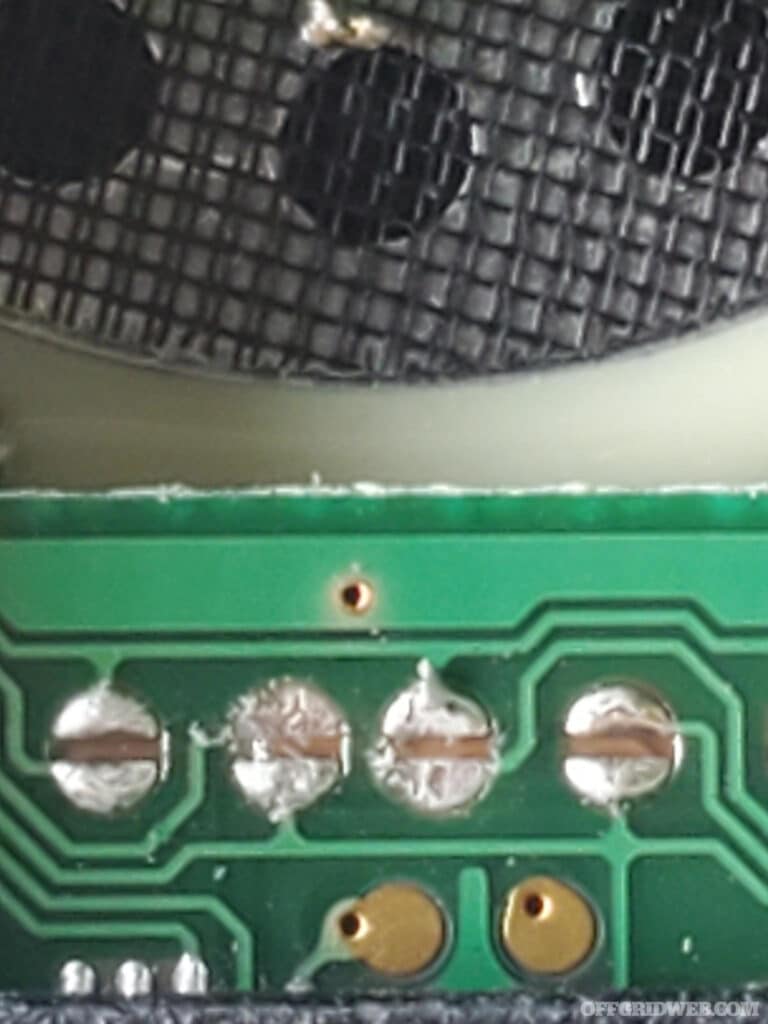
Step 3. Use your heated soldering iron and soldering wick to loosen and remove the jumpers, and make sure that everything is cleaned up.
Step 4. Replace the covering and battery.
Step 5. Reset the microprocessor by holding down the [mode], [0], and [V/M] buttons simultaneously while powering on the unit.
Step 6. Press the [F] key when prompted to do so.
If you have any pre-existing channel settings, this will wipe them out, so you’ll need to reload them with your programming software. However, at this point in time, you’re good to go and can transmit outside of the amateur radio bands.
Resilience
Resilience is another place where the Yaesu VX-6R shines. It’s marketed as submersible and has a JIS7 rating that’s roughly equivalent to an IPx7 rating. It can be submerged in about 1m of water for 30 or so minutes without any damage. The waterproofing is bolstered by both a gasket-and-screw system on the accessory jack, as well as a locking battery compartment.
Underneath the battery is a removable waterproof membrane that allows access to the circuit board area necessary for conducting the MARS/CAP mod or for installing expansion modules.
Ecosystem
The Yaesu VX-6R has a solid accessory system. Amplified and unamplified PTTs with the waterproof connector can be had from Disco32 or Armorwerx, allowing you to use both high-impedance commercial and low-impedance military headsets with the radio. While this handset’s dimensions are shorter than many of its competitors, including the others covered in this review, there are vendors such as Spectre Gear which make MOLLE-compatible radio pouches specifically for its form factor.
Additionally, while the VX-6R is an analog radio (though it does support the proprietary Wires protocol for talking to Internet-linked radio systems), the same waterproof connection is used by the Motorola/Vertex Standard EVX-S24 digital (DMR) radio. Thus, for groups leveraging Tier 2 DMR to communicate, you can have one gear setup which supports both radios as needed.
Overall Impression
With a wide-band receiver, tri-band transmit, good third-party support, and rugged construction, the Yaesu VX-6R is perhaps the ultimate analog radio for the preparedness-minded individual. Perhaps its only drawback is the belt clip, which lacks spring loading and should not be clipped through PALS webbing without a dummy cord.
For those who like quantifiable points of comparison, here’s a breakdown my rating on a scale of 1 to 10 (10 being the highest rating) for each radio against each criteria:
Baofeng UV-9R Plus
Radioddidty GS5B
Yaesu VX-6R
Communications is key to mission success and survival. Just like firearms, having the best you can afford and will carry and train with regularly is important. The quality, availability of aftermarket accessories, and ease of operation is also a key consideration. But unlike firearms, you can’t make your choice solely based on your own preferences — your radio needs to work with the radios carried by everyone you need to talk to.
While none of these radios are perfect, they each have their strengths, and I own them all for different purposes. The UV-9R is a rugged radio that anyone who has ever used another Baofeng platform will instantly understand, but which will hold up to more abuse than the UV-5R at a similar price point.
The Radioddity GS-5B’s unique features make it an excellent choice for public safety volunteers, and it’s earned a place in my SAR turnout kit. The Yaesu VX-6R’s rugged reliability, wide-band receiver, and capacity for expansion makes it a tool I’d trust my life to.
Regardless of your budget or what you’re preparing for, you should ensure you have multiple methods of communication with as many people as possible. Even if your cell phone is your primary day-to-day comms device, don’t forget that it’s fragile, susceptible to fast battery depletion, and reliant on signal from a network of towers that can be easily disrupted.
A quality handheld radio can communicate directly with your friends and family — no network or monthly payments required — and will be durable enough to withstand a variety of outdoor activities. These radios are my personal recommendations depending on your budget, but that doesn’t mean they’re the last word. I encourage you to use this framework to determine what’s important to you and evaluate your options accordingly.
Subscribe to Recoil Offgrid's free newsletter for more content like this.
Editor's Note: This article has been modified from its original version for the web.

 STAY SAFE: Download a Free copy of the OFFGRID Outbreak Issue
STAY SAFE: Download a Free copy of the OFFGRID Outbreak Issue
No Comments